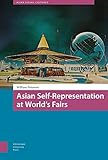Asian Self-Representation at World's Fairs / William Peterson.
Material type: TextSeries: Asian Visual Cultures ; 8Publisher: Amsterdam : Amsterdam University Press, [2020]Copyright date: ©2020Description: 1 online resource (318 p.)Content type:
TextSeries: Asian Visual Cultures ; 8Publisher: Amsterdam : Amsterdam University Press, [2020]Copyright date: ©2020Description: 1 online resource (318 p.)Content type: - 9789048536788
- 382 23
- T396 .P484 2020
- online - DeGruyter
| Item type | Current library | Call number | URL | Status | Notes | Barcode | |
|---|---|---|---|---|---|---|---|
 eBook
eBook
|
Biblioteca "Angelicum" Pont. Univ. S.Tommaso d'Aquino Nuvola online | online - DeGruyter (Browse shelf(Opens below)) | Online access | Not for loan (Accesso limitato) | Accesso per gli utenti autorizzati / Access for authorized users | (dgr)9789048536788 |
Frontmatter -- Table of Contents -- List of Figures -- Acknowledgements -- Note on Works Cited -- Note on Asian Names -- 1. Introduction -- 2. The Master of the Form -- 3. The New China and Chinese-Americanness -- 4. Performing Japan in the ‘World of Tomorrow’ -- 5. From ‘Panda Diplomacy’ to Acrobat Diplomacy -- 6. Fashion, Dance, and Representing the Filipina -- 7. Performing Modernity under Sukarno’s ‘Roving Eye’ -- 8. Maximizing Affect, Minimizing Impact with Hansik -- 9. Hard and Soft Power in the Thai Pavilion -- 10. Conclusion -- Works Cited -- Index
restricted access online access with authorization star
http://purl.org/coar/access_right/c_16ec
International expositions or "world's fairs" are the largest and most important stage on which millions routinely gather to directly experience, express, and respond to cultural difference. Rather than looking at Asian representation at the hands of colonizing powers, something already much examined, this book instead focuses on expressions of an empowered Asian self-representation at world's fairs in the West after the so-called golden age of the exhibition. New modes of representation became possible as the older "exhibitionary order" of earlier fairs gave way to a dominant "performative order," one increasingly preoccupied with generating experience and affect. Using case studies of national representation at selected fairs over the hundred-year period from 1915-2015, this book considers both the politics of representation as well as what happens within the imaginative worlds of Asian country pavilions, where the performative has become the dominant mode for imprinting directly on human bodies.
Mode of access: Internet via World Wide Web.
In English.
Description based on online resource; title from PDF title page (publisher's Web site, viewed 03. Jan 2023)


